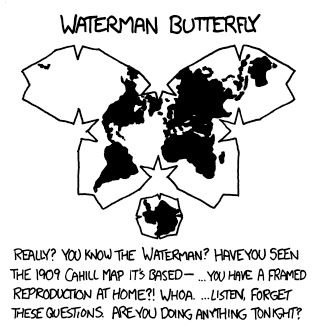One can interpret the maps as: Rural children are diagnosed less than children in large cities
I don’t know, a lot of the red is over pretty rural areas in the south and parts of the southwest, and the majority of the most rural parts of the country are “not significant”.
Also that big blue part in the middle covers some very large cities.
All kinds of medical regulation, financing etc. could lead to differences like this.
The ‘not significant’ part could be due to low numbers in general, so they can’t get the variances small enough to get low p numbers. It’s a quote that I can’t quite remember perfectly that is well known in sociology/psychology: “The only reason our findings aren’t significant is because we’re too damn lazy to drag enough people in for the study.”
Map can be interpreted as “if you look for something, you’ll find it.”
Could also be effects of air pollution or something. There’s not enough information to tell.
But yeah, maps like this are almost always cities doing things differently than rural areas.
The middle of nowhere Montana has more pollution than downtown Dallas?
Well the point was more “unknown environmental effects” rather than air pollution specifically.
Isn’t the oil industry doing stuff up in Montana?
Could represent genetic distribution. Autism is heritable.
Yeah. Could also be that spending time outside also helps. (The causation might be reversed though).
Absolutely not. There’s some hugely populated places in cold spots here and very rural hot spots. Rural Georgia is all red here. The greater San Francisco bay area is a cold spot. Dallas-Ft. Worth, Minneapolis, Seattle too. Some very rural parts of Mississippi are hot spots here.
For reference. That middle blue spot is centered on the DFW metroplex. An area of over 8.4M people in the center. What that most likely means is there are a large number there that are undiagnosed likely due to political and educational reasons.
Nah, that’s centered on Oklahoma. It includes DFW, but that’s basically all of Oklahoma.
Holy shit man, yeah DFW is big but not that fucking big lmao
DFW is big and getting bigger
I am going with regional insurance/medical provider policy on coverage of the diagnosis. If an autism diagnosis gets more covered care, it’s diagnosed more. If other diagnosis gets the patient the care that they need, it’s another disease that overlaps.
Maybe, or maybe it’s environmental, or just statistically insignificant. With no further information on what their “confidence” is in, exactly, this is basically map gore.
I strongly suspect the modern “spectrum” is just grouping and labeling certain personality profiles that have always existed in roughly similar proportions. Meaning that it’s not the proportion that is increasing, it’s that we chose to define certain combinations of human traits as ASD.
On the whole this labeling is probably useful since more people will get the support they need. But the point of delineation is mostly arbitrary.
Same way there’s suddenly more lefthanders or LGBT+ people now that we don’t beat it out of them as much anymore.
Now I want to see a line graph of left handedness and LGBTQ over time.
The graph looks something like this: /
No, I mean two lines showing the change in each over time, not the correlation between each other.
I can draw you one, but it would just come out as a pen smudge 😔
Autism is indeed just a label how the medical world identifies us.
Neurodivergent is how we identify ourselves and i believes it fits your observations very well.
https://en.m.wikipedia.org/wiki/Neurodiversity
This map likely only looks at diagnosis and ignores dyslexic and adhd types.
Strongly heriditary. When you married within the local village the chance/risk of your spouse also being on the spectrum was lower than when you matchmake through online services and hundreds of dates.
/non-diagnosed GenX with two out of three kids diagnosed so far
Genotype x Environment = Phenotype.
So is it genetic background or is it your neurodivergent modeling of the behavior to them?
FYI it can’t be determined without a much more in-depth genetic studies. This is especially true with complex multi-gene interaction traits like autism seems to be.
Wife is a psychologist working in diagnosis of ADHD and autism. I’ll go with the knowledge I’ve gotten from there. Thanks.
The Bay Area is a cold spot?
And is that Seattle in the northwest? Strange.
Yeah right. That was one of the first things I noticed.
Without knowing what the definition of hot and cold, it is difficult to make conclusions.
Is there a source paper?
There is a researchgate link in the post body that has more info and a link to the publication. I haven’t skimmed through it myself, but I thought I’d link for anyone who’s curious.
Ah, thank you. I only saw the image on that link. At the top of the page in a “view paper”.
Prevalence estimates of autism spectrum disorder (ASD) point to geographic and socioeconomic disparities in identification and diagnosis. Estimating national prevalence rates can limit understanding of local disparities, especially in rural areas where disproportionately higher rates of poverty and decreased healthcare access exist. Using a small area estimation approach from the 2016–2018 National Survey of Children’s Health (N = 70,913), we identified geographic differences in ASD prevalence, ranging from 4.38% in the Mid-Atlantic to 2.71% in the West South-Central region. Cluster analyses revealed “hot spots” in parts of the Southeast, East coast, and Northeast. This geographic clustering of prevalence estimates suggests that local or state-level differences in policies, service accessibility, and sociodemographics may play an important role in identification and diagnosis of ASD. County-Level Prevalence Estimates of Autism Spectrum Disorder in Children in the United States.
Georgia and Alabama, huh?
Guess that proves it isn’t vaccines.
Yeah, I tried to get anything else at all out of this image and I couldn’t, but the vaccine thing man - if not getting vaccines had anything to do with it this map would look very different.
Is this about where a diagnosis happens or where a diagnosed person resides?
There’s an area where most the US military, or at least the US Army, sends their servicepeople with disabled children to consolidate access to services and that area is marked ‘cold’.
Can confirm, from east coast, have autism.
Well that settles that.
Does United healthcare “cover” ASD screenings in those blue areas?
In a world where everyone wants your money and time and a couple of different words can make the difference between a reasonable or bad contract. Attention to detail stonks are going up!
How interesting. I’ve always suspected that I have autism and I sort of grew up in California and recently moved to the south due to circumstances beyond my control. There definitely seems to be a vibe in the bay area that doesn’t mesh with me, like idk but people there seem very superficial and “other” compared to me. I lived in the central valley though so I never really became immersed in it but Santa Cruz in particular seems like a very small social club of neurotypicals who make surfing and ketamine overindulgence and being a flaming douchebag their entire personality while making fun of outsiders, which aside from the skating and bi-daily DMT use and making sure you drive a 1998 Subaru to symbolize your tribal membership is pretty textbook neurotypical behavior. On the other hand though, now unfortunately living in one of the red areas of the map in Alabama, I’ve found that the people here are downright cruel. Nearly every interaction I have here leaves a bad taste in my mouth and makes me want to get back at them in the same passive aggressive way they try to fuck with me. I feel like I’m surrounded by sociopaths here. I guess moral of the story is that the vast majority of humans, autism spectrum or not, are trash and deserve bad things to happen to them. Karma isn’t real sadly.
San Fran vs LA is pretty fascinating. A whole lot of extra variables should be closer to constant in that particular case.










